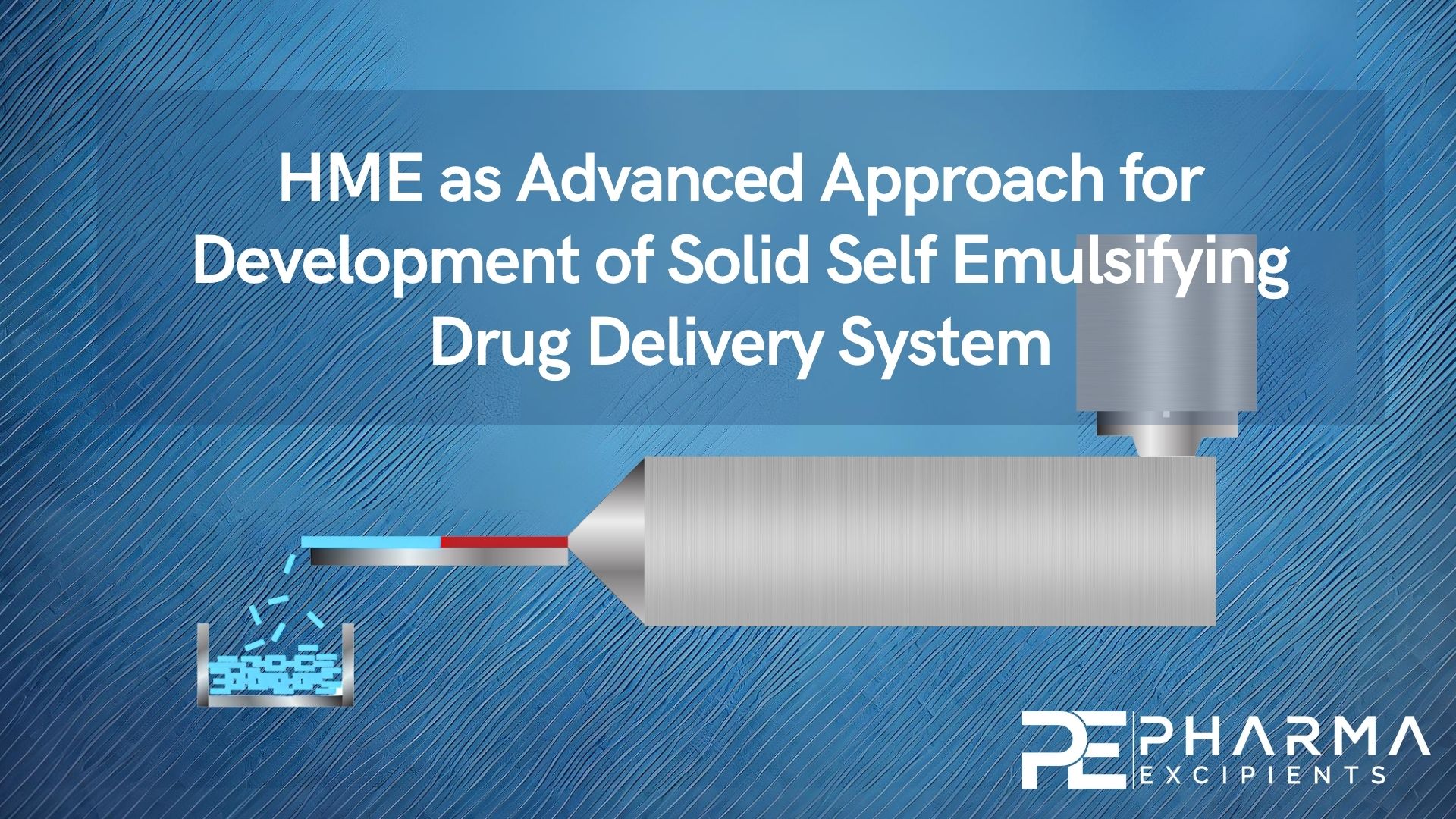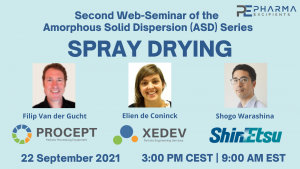HME as Advanced Approach for Development of Solid Self Emulsifying Drug Delivery System

The pharmaceutical industry is paying more and more attention to hot-melt extrusion (HME), but this technology’s promise for creating solid self-emulsifying drug delivery systems (S-SMEDDS) has not yet been fully realized. The numerous published publications over the past five years show that hot melt extrusion (HME) technology is increasingly being used for novel applications. Because it has low-cost scale-up capabilities and process automation, which reduce labour costs and capital expenditure. HME has become a crucial technique for pharmaceutical manufacturing and research applications involving drug delivery. In the development of new drug delivery systems, the novel use of the HME method offers a promising alternate strategy. Through a discussion of pertinent case studies, the current review examines the value of HME in the creation of innovative drug delivery systems.
Table 1: Solidification of Liquid self-emulsifying drug delivery by different technique
| Drug | Matrix | Description | Solidification technique | Ref. |
|---|---|---|---|---|
| Dapson | Aerosil | Development of solid self-microemulsifying drug delivery (S-SMEDDS) of dapsone (DP) by adsorbing on neusilin US2 and spray drying with aerosil 200. The optimized formulation of LSMEDDS (F8) containing capryol 90 (10 percent w/w), Tween 80 (67.5/5 w/w), and labrasol (22.5 percent w/w) showed the smallest particle size and (10.3) and Solid SEEDS particle size 87.5 ± 4.95 with yield 30.6% to 42.66%. | Spray drying | (Mahore et al., 2021) |
| Resveratrol | Colloidal silicone dioxide | A solid self-emulsifying drug delivery systems was developed by using the spray-drying approach, to increase the solubility of resveratrol (RES). Three surfactant systems, soy phosphatidylcholine (SPC), eumulgin® HRE-40 (EU), and sodium oleate (system A); SPC/Tween®80 (TW) and sodium oleate (system B); and SPC/EU/TW (System C), were tested along with cod liver oil. System C produced the highest incorporation (21.26 mg/ml). The highest yield solid self-emulsifying drug delivery systems (80.12) were made with colloidal silicon dioxide (CSD). | Spray drying | (Aloisio et al., 2019) |
| Methotrixate | Calcium silicate | To create a novel solid self-microemulsifying drug delivery system (SMEDDS) that contains methotrexate (MTX) and has improved bioavailability and photostability. Spray drying liquid SMEDDS with the solid carrier produced the solid SMEDDS. The liquid SMEDDS droplet size of 189.336.61 nm and the solid reconstituted particle size of 126.734.32 nm were used to optimize the formulation. | Spray drying | (Kim et al., 2019) |
| Bambuterol hydrochloride | Microcrystalline cellulose: aerosil | The solid self-emulsifying drug delivery system of bambuterol hydrochloride was prepared by adsorption technique using microcrystalline cellulose:aerosil mixture as the adsorbent. The formulations were optimized with droplet size of solid SEDDS100 and 300 nm. | Adsorption to solid carrier | (Saggar et al., 2019) |
| Iloperidone | Syloid XDP and Aerosil 200 | Solid self microemulsifying drug delivery system (SMEDDS) and liquisolid compact (LSC) of Iloperidone were developed (ILO) for improvement of oral bioavailability. The composition of formulation Capmul MCM, Labrafac WL 1349 as oils, Lauroglycol 90 and PEG 600 as surfactant and co-surfactant. Syloid XDP and Aerosil 200 were optimized as carrier and coating material in the ratio of 15:1 w/w for liquid solid formulation. | Adsorption to solid carrier | (Suram et al., 2020) |
| Piroxicam | Neusilin US2 (magnesium aluminometa silicate) | Solid self-micro emulsifying drug delivery system was prepared by adding liquid self-micro emulsifying drug delivery system with Neusilin US2 and filled in hard gelatin capsule. The droplet size and PDI value of optimized batch was found to be 138.8 nm respectively 0.519 with drug content 98%. | Adsorption to solid carrier | (Pattewar et al., 2018) |
| Osthole | Ethylcellulose (EC) and Eudragit S100. | Solid self-microemulsifying drug delivery system (SSMEDDS) of osthole was developed by spherical crystallization technique. liquid self-microemulsifying drug delivery system (L-SMEDDS) of osthole was formulated with castor oil, Cremophor RH40, and 1,2- propylene glycol. The optimized osthole S-SMEDDS had a high yield (83.91 ± 3.31%) and encapsulation efficiency (78.39 ± 2.25%). | Spherical crystallizatio n technique. | (Sun et al., 2018) |
| Fenofibrate | Santa Barbara Amorphous15 (SBA-15) mesoporous silica and Aerosil® 200 with soluplus (inhibitor) | Novel supersaturated Solid self-emulsifying drug delivery system (super-SSEDDS) was developed by combining SSEDDS with appropriate precipitation inhibitor to overcome the thermodynamically instability and precipitation rapidly prior to absorption, resulting in compromised bioavailability. Particle size of Solid self-emulsifying drug delivery system125.23±1.50 nm while supersaturable solid having 132.78±1.27 nm. | Supersatura ble solid precipitation inhibition | (Quan et al., 2017) |
| Paclitaxel | Aerosil 200 | Paclitaxel (Ptx) solid-self-emulsifying drug delivery system (S-SEDDS) was created using the spray drying approach to increase Ptx's low bioavailability (BA). According to their solubilizing power, 10% oil (ethyl oleate), 80% of a surfactant mixture (Tween 80: Carbitol, 90:10, w/w), and 10% of a cosolvent (PEG 400) were selected. The prepared S-SEDDS had mean droplet sizes of 16.9 1.53 nm, zeta potentials of 12.5 1.66 mV, and encapsulation efficiencies of 56.2 8.1%, respectively. | Spray drying | (Cho et al., 2016) |
| Atorvastatin | Lactose (Lactochem® powder) | Liquid and solid self-emulsifying drug delivery systems (SEDDS) for poorly soluble atorvastatin was developed by spray drying technique. The liquid formulation was optimized by droplet size and zeta potential of CF 3 (188.1 ± 1.48 −30.2 ± 1.21) and OF 2 (190.5 ± 1.28−32.0 ± 3.20). Solid formulation have Particle size 330 nm with entrapment efficiency 52-53 % (EE). Better solubilisation properties were exhibited by solid formulation OF2 in-compare to liquid SEDDS formulation. | Spray drying | (CzajkowskaKośnik et al., 2015) |
Download the full article as PDF here: Hot-Melt Extrusion as Advanced Approach for SEDDS
or read it here
Shahid Jamil, Tariq Waece Sadeq, Abdul Samad, Hot-Melt Extrusion (HME) Is Advanced Approach for Development of Solid Self Emulsifying Drug Delivery System, https://www.researchgate.net/publication/375916569, International Journal of Membrane Science and Technology · August 2023, DOI: 10.15379/ijmst.v10i2.3187
Watch the recorded webinar Spray Drying – Web Seminar Series here:


